
Need to Vent
The next machine to explore alien worlds may slither rather than roll. NASA is currently testing a snake-like robot that its engineers hope will one day be deployed into the oceans of Saturn’s moon Enceladus, in search of possible signs of life in its frigid depths.
Dubbed the Exobiology Extant Life Surveyor (EELS), the over 14-foot robot is both autonomous and self-propelled, capable of tackling environments ranging from oceans, sands, rocks, and cliffs thanks to its flexible body made of articulated segments.
That kind of versatility will be crucial. As detailed in a new article published in journal Science Robotics, the researchers are focusing on designing EELS to plunge through vents in Enceladus’ icy crust that lead to the subsurface oceans, in which “there is substantial uncertainty with respect to its geometry and the physical properties.”
Solitary Serpent
To tackle these uncertain terrains, EELS doesn’t just need to be mobile — it needs to be smart, too. Its so-called “perception head,” colored black, comes equipped with an array of sensors and optical cameras to see its surroundings. These include light detection and ranging (LiDAR), stereo cameras, and a barometer.
The head also houses the brains of the operation. The goal is for its autonomous decision-making to be “risk-aware,” as it navigates vents and oceans miles beneath the surface of Saturn’s moon, where it’ll be out of contact with its human supervisors.
“We have been using glaciers as Earth analog ice environments to develop and test its architecture as a stepping stone toward Enceladus,” the authors wrote in the article.
Cool Customer
Enceladus has intrigued astronomers because data collected by the Cassini probe indicated it had subsurface oceans. That may be less novel now, as more and more moons appear to have oceans too, but one of the reasons Enceladus stands out is that it’s also been identified as having all the conditions needed for life.
Last year, observations made with the James Webb Space Telescope showed massive plumes of water bursting through its surface and spewing thousands of miles into space. These vents provide the most straightforward pathway to reaching the moon’s oceans, which would otherwise be inaccessible.
A snake-like robot would be well suited for exactly these kinds of conditions. Initially, it’ll need to navigate the hard surfaces of Enceladus. Then, descending in a coil, it can use its lengthy and flexible body to push against the walls of the vents in order to resist the water shooting up.
Of course, those capabilities also make EELS a great candidate to explore extreme environments on Earth like Antarctica, so perhaps we won’t have to wait for it to take to Saturn’s moon to see it in action.
More on robots: This Humanoid Robot Powered by OpenAI Is Almost Scary